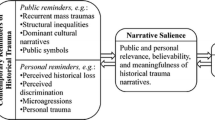Abstract
Based on ethnographic fieldwork carried out in West Bengal, India, Akshay Khanna examines the conditions under which epidemiological knowledge about ‘men who have sex with men’ is produced and brought to circulate. He looks at conditions under which particular idioms of gender and sexuality are transformed into epidemiologically over-determined identity categories. The Sexual Subject that circulates in development praxis as an embodiment-in-the-world, it is argued, would be better understood in terms of the political economy that makes its intelligibility and circulation possible.
Similar content being viewed by others
Notes
Sapphire creations, a dance troupe founded by Sudarshan Chakraborty has been a consistent presence in queer activist spaces, and at conferences of the HIV/AIDS industry over the years. For an analysis of its productions as ‘Queer Art’, see Puri (2005).
The argument is often made vis-à-vis the launda naach, and more broadly same-sex sex itself, that this is heterosexual eroticism, which cannot be expressed as such because women cannot be erotic in public spaces. In the context of the launda naach this argument is refutable at the outset as the women/girl is present as a sexual performer as the randi (a similarly located adolescent girl – though the term has various other meanings in north India) performing alongside the launda.
The ‘vertical disease control programme’, a phrase from public health discourse, used to describe interventions relating to malaria, tuberculosis and then HIV/AIDS, is as different from a ‘sector wide approach’ which would focus on developing the entire health sector rather than addressing one particular disease with indicators specific to that disease and a specialist bureaucracy that is independent of the health sector.
The epidemiological model is structured broadly around two axes of differentiation. The first is geographical classification on the basis of estimates of HIV prevalence – where the country is divided into ‘low’, ‘high’ and ‘moderate’ prevalence states. The second is that of types of people – ‘high-risk’/vulnerable groups, ‘bridge populations’ and ‘general population’. This is based on the presumptions that, first, these are ‘communities’ or ‘groups’ each with a peculiar sexuality. These presumptions are challenged as inadequate on a regular basis ‘in the field’. For instance, one of the problems with operationalizing targeted interventions with CSWs or commercial sex workers is that often the ‘sex worker’ as a type of person, or as a community, simply does not exist. This is not to say that women are not selling sexual services, but that the fact of their doing sex work need not be the basis of their identity at all. Women who sell sexual services often are also involved in other forms of employment – selling vegetables, working as construction workers, etc. As much as these women may be considered ‘sex workers’, they may be considered as vegetable traders, construction workers, adivasis, dalits, muslims, etc. What we are seeing then is that one aspect of their lives is being made to become the basis of identity as far as access to rights and services is concerned, and this aspect is ‘risk behaviour’. These are people, hitherto excluded from the benefits of citizenship, and are now being granted entry into the realm of citizenship only insofar as they form part of a ‘high risk group’. See Khanna (2007) for a detailed analysis of the same.
Elsewhere I argue, that these are Global Forms in that they are articulated as equivalent to various indigenous identities around the world – ‘MSM’ in absolutely different contexts come to be equivalent to each other. In India and Bangladesh it is the kothi, in Thailand, the kathoey, the warias in Indonesia, ponnaya in Sri Lanka, fletes in Peru, metis in Nepal, zenanas in Pakistan – these are all seemingly just different names for the same thing (Khanna, 2009).
See Cohen (2005), Reddy (2005), Boyce (2005) and Khanna (2009). These works have variously highlighted the socio-political conditions of the emergence of the Kothi in recent years and examine how and why this term has come to be so pervasive in the way same-sex sexuality in India is understood.
References
Boyce, Paul (2005) ‘“Conceiving Kothis”: Men who have sex with men in India and the cultural subject of HIV prevention’, Medical Anthropology 26: 175–203.
Cohen, Lawrence (2005) ‘The Kothi Wars: AIDS cosmopolitanism and the morality of classification’, in Vincanne Adams and Stacy Leigh Pigg (eds.) Sex in Development: Science, sexuality and morality in global perspective, pp. 1–38, Durham, NC: Duke University Press.
Khanna, Akshay (2006) The Right to Health and Sexuality, Mumbai: Cehat.
Khanna, Akshay (2007) ‘“Us, Sexuality Types” – A critical engagement with the post-coloniality of sexuality’, in Brinda Bose and Subhabrata Bhatacharyya (eds.) The Phobic and the Erotic: The politics of sexualities in contemporary India, New Delhi: Seagull Publications.
Khanna, Akshay (2009) ‘Meyeli Chhele becomes MSM – Transformation of idioms of sexualness into epidemiological forms in India’, in Andrea Cornwall, Jerker Edstrom and Alan Greig (eds.) Politicising Masculinity, London: Zed.
Manuel, Peter (1998) ‘Chutney and Indo-Trinidadian Cultural Identity’, Popular Music 17 (1): 21–43.
Marcus, George E. (1995) ‘Ethnography in/of the World System: The emergence of multi-sited ethnography’, Annual Review of Anthropology 24: 95–117.
Mosse, David (2005) Cultivating Development: An ethnography of aid policy and practice, London and Ann Arbor, MI: Pluto Press.
Puri, Siddharth (2005) ‘Performing Resistance: Queer art, artists and activism in Kolkata’, PART: Journal of the CUNY PhD in Art History (12).
Reddy, Gayatri (2005) ‘Geographies of Contagion: Hijras, kothis and the politics of sexual marginality in India’, Anthropology and Medicine 12 (3): 255–270.
Žižek, Slavoj (1989) The Sublime Object of Ideology, London: Verso.
Additional information
Examines the conditions under which epidemiological knowledge about ‘men who have sex with men’ is produced
Rights and permissions
About this article
Cite this article
Khanna, A. Taming of the Shrewd Meyeli Chhele: A political economy of development’s sexual subject. Development 52, 43–51 (2009). https://doi.org/10.1057/dev.2008.70
Published:
Issue Date:
DOI: https://doi.org/10.1057/dev.2008.70




